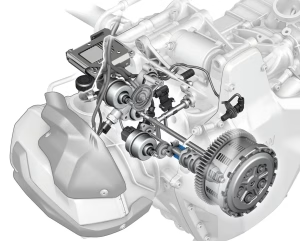BMW has type approved its longer-range R 1300 GS Adventure variant which, while not containing photos, reveals key figures for the new R 1300 GS Adventure including its weight, performance and dimensions.
It’s a full 21kg heavier than the standard GS when fully fuelled and has a maximum loaded weight that’s 20kg more than the base version, suggesting the whole bike is being bulked up.
The engine, of course, is straight from the R 1300 GS, retaining the same 107kW (143hp) peak power output at 7750rpm and an unchanged peak torque of 149Nm at 6500rpm, but the Adventure’s top speed dips from the R 1300 GS’s 225km/h to 220km/h. That’s probably a function of aerodynamics rather than anything else, as the Adventure is substantially taller with a screen that tops out at 1538mm in its lowest setting and can rise to 1588mm. For comparison, the standard GS screen height ranges from 1376mm to 1426mm.
Although the increased height and the ‘Adventure’ designation of the bike hints at taller suspension than the standard version, the wheelbase isn’t increased. In fact, the measurement between the axles is 8mm shorter than the standard bike at 1510mm and the overall length is reduced 4mm to 2208mm. That could mean a shorter fork or a steeper rake. The wheel sizes are unchanged with the same 120/70-19 front and 170/60-17 rear tyre dimensions.
Semi-auto versions too!

Both the Adventure and base R 1300 GS will be available for 2025 using the company’s new ASA (automatic shift assistant) servo-operated clutch and shifter.
This still uses your left foot to swap ratios in manual mode, but via electronic actuation rather than a mechanical linkage so the semi-automatic bikes don’t carry any weight penalty compared to the manual versions. That’s a key selling point in comparison to Honda’s more complicated DCT semi-auto, as used on the Africa Twin, which adds 11kg to the mass.
WORDS: BEN PURVIS











